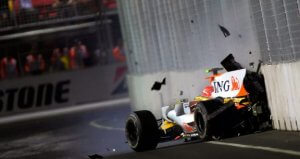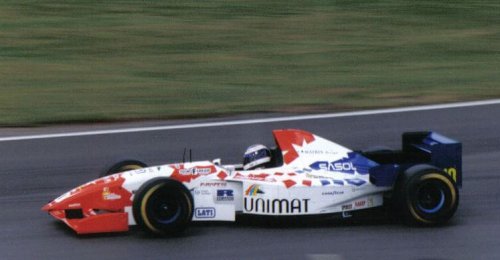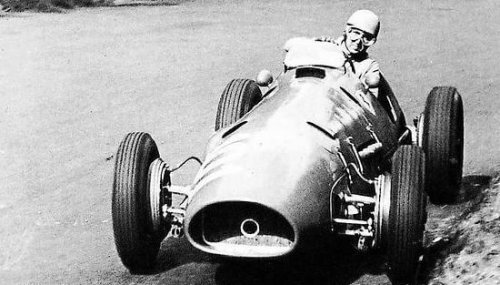The Most Surreal Accidents in Formula One

In almost seven decades of Formula One, we’ve been provided with a lot of entertainment. However, during these 68 years, there have been accidents that made our hearts shrink and that sadly, have taken the lives of some drivers. Today, we’ll set aside sadness and remember the most surreal accidents in Formula One. These accidents all ended in nothing more than scares, with no loss of life. Next, we will mention some of the more memorable accidents that we’d expect to see in a science fiction movie rather than real life.
Nelson Piquet Jr’s surreal accident
The story of Nelson Piquet’s crash in the Singapore Grand Prix could easily be a movie script. What started as a simple accident ended up being a sporting scandal. It all started in the Singapore Grand Prix in 2008 when Nelson Piquet hit the guard rails. This provoked the safety car to enter the racetrack.
Later it was proved that Renault authorities had forced him to provoke an accident. This way Alonso, who was in the last position on the grid, would win the race.
Ultimately the FIA decided not to punish the Spanish driver because it could not be proven that he had knowledge of the plan. In fact, Flavio Briatore was sanctioned and banned for life from Formula One racing.
Taki Inoue’s surreal accidents in Formula One
This is undoubtedly one of the most surreal accidents in Formula One. If it’s bizarre that a safety car hits a driver once, it’s astonishing that he’s hit twice in two different races. Taki Inoue is still remembered for these incidents, besides being considered as the worst driver in Formula One history.

The accidents took place during the same season. The first was during the classifying season of the Monaco Grand Prix. Inoue’s breaks failed and the tow truck (instead of removing him from the track) took him back to the asphalt. The safety car was passing and hit Taki Inoue who was still on the racetrack.
The second impact took place in the Hungarian Grand Prix of 1995. Taki Inoue had trouble with his single-seater and was standing in the middle of the racetrack.
The driver was standing beside his single-seater trying to put out a fire with an extinguisher. Meanwhile, the ambulance was on its way to help the driver. Inoue was too busy handling the extinguisher and did not see the ambulance coming towards him. The ambulance driver couldn’t avoid him and ended up hitting Inoue. Since a picture paints a thousand words, here is the video that has to be seen!
Alberto Ascari ends up in the sea
Fortunately, an accident such as this is unthinkable these days. Formula One is much safer now than in the 50s and the risks of those days are long gone today. Alberto Ascari‘s surreal accident took place in 1955 on the circuit of Monaco. The Italian driver was about to take the chicane by the port and ended up in the sea. Miraculously, Ascari was rescued and happily, the incident ended up becoming nothing more than a scare.

After being saved from a potentially fatal accident, Ascari passed away a few days later during a testing session in the circuit of Monza. The session was informal, with a group of friends. He was not wearing a helmet or any type of protection and the accident proved fatal.
In almost seven decades of Formula One, we’ve been provided with a lot of entertainment. However, during these 68 years, there have been accidents that made our hearts shrink and that sadly, have taken the lives of some drivers. Today, we’ll set aside sadness and remember the most surreal accidents in Formula One. These accidents all ended in nothing more than scares, with no loss of life. Next, we will mention some of the more memorable accidents that we’d expect to see in a science fiction movie rather than real life.
Nelson Piquet Jr’s surreal accident
The story of Nelson Piquet’s crash in the Singapore Grand Prix could easily be a movie script. What started as a simple accident ended up being a sporting scandal. It all started in the Singapore Grand Prix in 2008 when Nelson Piquet hit the guard rails. This provoked the safety car to enter the racetrack.
Later it was proved that Renault authorities had forced him to provoke an accident. This way Alonso, who was in the last position on the grid, would win the race.
Ultimately the FIA decided not to punish the Spanish driver because it could not be proven that he had knowledge of the plan. In fact, Flavio Briatore was sanctioned and banned for life from Formula One racing.
Taki Inoue’s surreal accidents in Formula One
This is undoubtedly one of the most surreal accidents in Formula One. If it’s bizarre that a safety car hits a driver once, it’s astonishing that he’s hit twice in two different races. Taki Inoue is still remembered for these incidents, besides being considered as the worst driver in Formula One history.

The accidents took place during the same season. The first was during the classifying season of the Monaco Grand Prix. Inoue’s breaks failed and the tow truck (instead of removing him from the track) took him back to the asphalt. The safety car was passing and hit Taki Inoue who was still on the racetrack.
The second impact took place in the Hungarian Grand Prix of 1995. Taki Inoue had trouble with his single-seater and was standing in the middle of the racetrack.
The driver was standing beside his single-seater trying to put out a fire with an extinguisher. Meanwhile, the ambulance was on its way to help the driver. Inoue was too busy handling the extinguisher and did not see the ambulance coming towards him. The ambulance driver couldn’t avoid him and ended up hitting Inoue. Since a picture paints a thousand words, here is the video that has to be seen!
Alberto Ascari ends up in the sea
Fortunately, an accident such as this is unthinkable these days. Formula One is much safer now than in the 50s and the risks of those days are long gone today. Alberto Ascari‘s surreal accident took place in 1955 on the circuit of Monaco. The Italian driver was about to take the chicane by the port and ended up in the sea. Miraculously, Ascari was rescued and happily, the incident ended up becoming nothing more than a scare.

After being saved from a potentially fatal accident, Ascari passed away a few days later during a testing session in the circuit of Monza. The session was informal, with a group of friends. He was not wearing a helmet or any type of protection and the accident proved fatal.
All cited sources were thoroughly reviewed by our team to ensure their quality, reliability, currency, and validity. The bibliography of this article was considered reliable and of academic or scientific accuracy.
- Masmejean, E. H., Chavane, H., Chantegret, A., Issermann, J. J., & Alnot, J. Y. (1999). The wrist of the formula 1 driver. British Journal of Sports Medicine. https://doi.org/10.1136/bjsm.33.4.270
- Phillips, A. J. K. (2014). Uncovering formula One driver performances from 1950 to 2013 by adjusting for team and competition effects. Journal of Quantitative Analysis in Sports. https://doi.org/10.1515/jqas-2013-0031
- Schreyer, D., & Torgler, B. (2018). On the Role of Race Outcome Uncertainty in the TV Demand for Formula 1 Grands Prix. Journal of Sports Economics. https://doi.org/10.1177/1527002515626223
- Chaves, M. C. de C., Gomes Júnior, S. F., Pereira, E. R., & Soares de Mello, J. C. C. B. (2010). ELECTRE II multicriteria method to evaluate Formula 1 world championship drivers. Production. https://doi.org/10.1590/S0103-65132010005000012
This text is provided for informational purposes only and does not replace consultation with a professional. If in doubt, consult your specialist.








